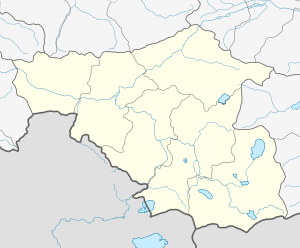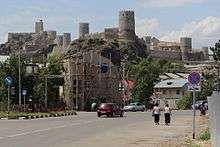Rabati Castle
Rabati Castle (Georgian: რაბათის ციხე) is a medieval fortress built in the 9th century under the name "Lomisa Castle" in the city of Akhaltsikhe in southern Georgia, recently globally reconstructed. One of the main attractions of the Samtskhe-Javakheti region along with Vardzia
| Rabati Castle | |
|---|---|
რაბათის ციხე | |
 | |
 Location within Georgia  Rabati Castle (Samtskhe-Javakheti) | |
| Former names | Lomsia; Lomisa |
| General information | |
| Location | Akhaltsikhe, Samtskhe-Javakheti |
| Country | Georgia |
| Coordinates | 41°38′33.6″N 42°58′37.4″E |
| Elevation | 1,000 m (3,281 ft) |
| Completed | 9th century[1] |
| Renovated | 2012 |
| Renovation cost | 26 mln ₾[2] |
| Client | Guaram Mampali[3] |
| Technical details | |
| Floor area | 70,000 m2 (750,000 sq ft)[2] |
Name
The original name of the fortress in the 9th century was Lomisa/Lomsia, which can be translated from Georgian as "Lion", at the end of the 12th century, Lomisa acquired the new name Akhal-tsikhe, which literally translates as “New fortress”, the modern name “Rabati” is of Jewish/Arabic origin and means any fortified place. Rabati was usually called the trading quarter at the fortress, earlier mainly Jewish merchants and craftsmen lived in the Rabat quarter, however, the name gradually stuck to the all fortress itself. [4][5]
History

According to the Georgian Chronicles the city was established in the 9th century by Guaram Mampal, son of the King of Tao. At the end of the 12th century Lomisa turned into a real city with the new name Akhal-tsikhe (New Fortress), which in addition to the fortress had a serious system of city-wide fortifications – high walls, guarded entrance gates and watch towers. From the 13th to the end of 14th centuries it was the capital city of Samtskhe-Saatabago, ruled by the Georgian princely (mtavari) family and a ruling dynasty of the Principality of Samtskhe, the House of Jaqeli.[6]
In 1393 the city was attacked by the armies of Tamerlane. Despite the Turko-Mongol invasions, the fortress withstood and continued to thrive. After the Treaty of Constantinople in 1590, the whole territory of Samtskhe-Saatabago came under the rule of Ottoman Empire. Turks Mostly used to build defensive edifices. In 1752 the first mosque was built in Rabati.
Metropolitan John writes in the late 18th century that "despite the fact that a large part of the population has been Islamized, there's still a functioning Orthodox church". After the Treaty of Georgievsk between the Kingdom of Kartli and the Russian Empire was signed, the question of the fate of Akhaltsikhe arose. The first attempt to take the fortress in 1810 failed. Prince Paskevich successfully stormed the fortress 18 years later, in the great Battle of Akhalzic. After the Treaty of Adrianople in 1829, the Ottomans yielded part of Akhaltiske Region.
The fortress and its adjacent buildings were extensively rebuilt and renovated in 2011–2012 in order to attract more tourists to the area.
Restoration
In May 2011, the reconstruction of the Rabati fortress began, which was accompanied by the restoration and completion of many buildings that were destroyed in time immemorial. For this purpose, the Government of Georgia allocated 34 million lari from the state budget. As part of the project, the Akhmediye Mosque, the mosque minaret, the madrasah, the Jakeli castle, baths, the citadel, the walls of the fortress and the Orthodox Church were updated on the territory of the fortress. The tunnel leading to the Potskhovi River was also restored. As part of the project, two main streets of the fortress were repaired, a pavement was equipped, and the facades and roofs of buildings were restored.
Panorama

References
- "რაბათის ციხე-სიმაგრე". იმოგზაურე საქართველოში. Retrieved 9 March 2017. (in Georgian)
- "ახალციხის რაბათი – ისტორიული არქიტექტურის მეტამორფოზა". Manana Suramelashvili. 17 December 2012. Retrieved 9 March 2017. (in Georgian)
- "ისტორიული და არქიტექტურულ–კულტურული ძეგლები". Akhaltsikhe Municipality. Retrieved 9 March 2017. (in Georgian)
- [https://xn--b1algemdcsb.xn--p1ai/wd/%D1%80%D0%B0%D0%B1%D0%B0%D1%82
- https://www.radiotavisupleba.ge/a/24393159.html
- [https://castles.today/ru/zamki/gruziya/akhaltsikhe/istoriya/